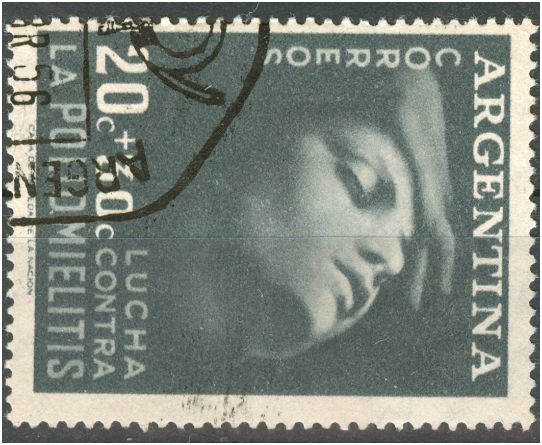O = Zárate Grené, introduced in 1954, having clear rhombos (hence the name).
Reference point in the commemoratives is
MT 559 = 14.04.1956 Polyomyelitis


|
This group of papers is even more difficult than the coated papers [tizado] as the design of the watermark is rather vaguely present, the paper mesh can only be certified when using x-ray type methods as by computer scanning. Whaty is supposed to help is that the diameter of the suns are a lot smaller than in the imported papers [except for the Austrian paper of 1937!]. So how can we get along??? N = Zárate Rayado Horizontal , introdued on the 21.08.1953 for several values of the Evita definitives: 1c, 10c, 20c, 25c and 50c. Commemoratives mentioned by Pettigiani:
According to Pettigiani of the above mentioned Evita's only the 10c and 20c do occur also in "O" [Zárate grené]. I can show you the 25c as well!!! This "N" is assigned watermark type VI thus contrasting with all the other Zárate papers that have type V. This implies that there should have been a second dandy-roll used by Zárate! So far we all had agreed there is only ONE! All Zárate papers have an orthogonal watermark, some have a symmetrical paper mesh, some an asymmetrical one. N has the asymmetrical! |
| ....
O = Zárate Grené, introduced in 1954, having clear rhombos (hence the name). Reference point in the commemoratives is MT 559 = 14.04.1956 Polyomyelitis
|
|
P = Granulado vertical, introduced also in 1954, having less clear rhombos if at all (hence the name). Reference point in the commemoratives is MT 612 = 12.12.1959 San José de Flores
|
|
Q = Zárate blanco, introduced in 1955, having a much whiter appearance (hence the name). Reference point in the commemoratives is MT 601 = 03.10.1959 Red Cross symmetrical:
asymmetrical:
For Dario Bardi the Red Cross stamp is the reference point for the asymmetrical version: ZA 3 = Zárate Blanco Rayado. Pettigiani is in doubt how to classify this stamp- he even thinks of a Tela! In his book there is nothing like Bardi's ZA 4 = Zárate Blanco Granulado! |
|
What remains unclear in the description of the National Papers is the aspect of had the felt side of the paper been printed or not? Predominantly Zárate has the wire side printed and the felt side received the gum - the watermark letters we see from the back read like AЯ .... The paper itself is transposed i.e. the gummed side of the stamp is the felt side of the paper, the front of the stamp shows missing fibres. What this means is that the dandy-roll reads RA!!! Not AЯ as in practically all other watermarks! The dandy-roll reading RA results in the felt side having AЯ and as the felt side has been gummed we indeed read AЯ from the back of the stamp! All Zárate papers have in common a watermark that comes from a dandy-roll reading RA ... Why couldn't Pettigiani say a word about this aspect??? Having the felt side at the back and the wire side at the front also explains the indents of the wire so clearly visible at the front! In the exceptional cases in the usage of the Zárate paper i.e. that when the paper got gummed - never simultaneously with the paper production - on the proper side i.e. the wire side, the watermark will read RA ! This is what the Argentine philatelist will call "filigrana traspuesta" Dario Bardi in his 2008 Clasificacion had suggested that practically all Zárate paper had had "filigrana traspuesta". I read it as "papel traspuesto" in the sense that the felt side had got the gum. Later from the P&R Catalogue it became clear that the "traspuesta" referred to more exceptional cases... and not all of the printings.... The felt side being the gummed side has other consequences! It causes the back side of the stamp having a more closed surface and thus by default the paper mesh will be less visible and might be called "closed" or "cerrada"! Turning a "grené" into a "granulado"... Which makes the distinction between O and P less relevant... |